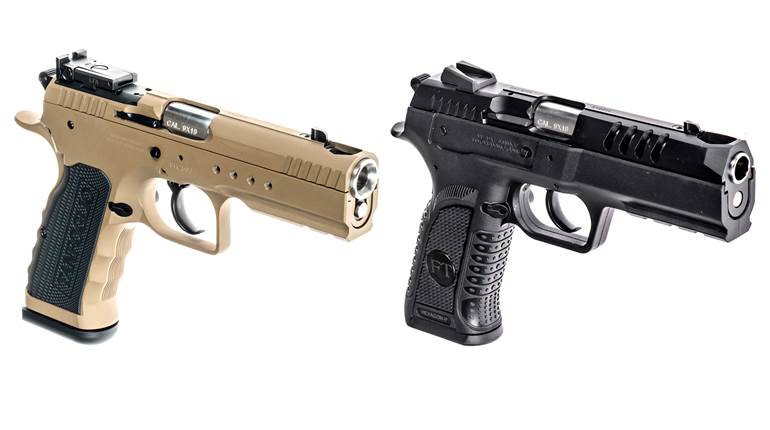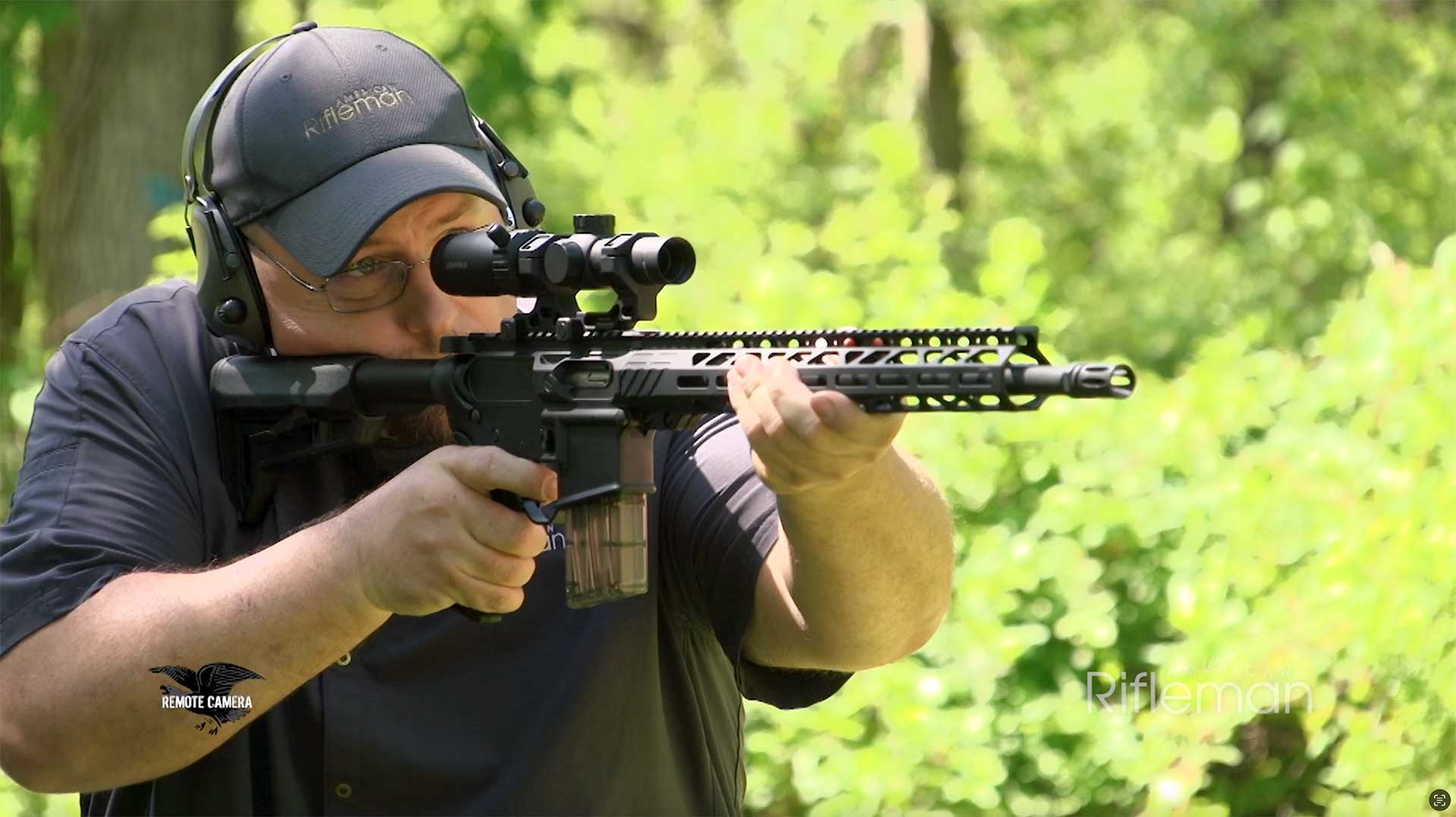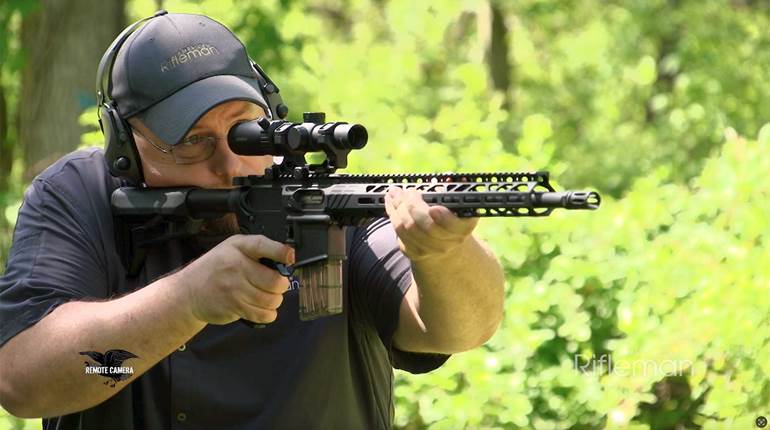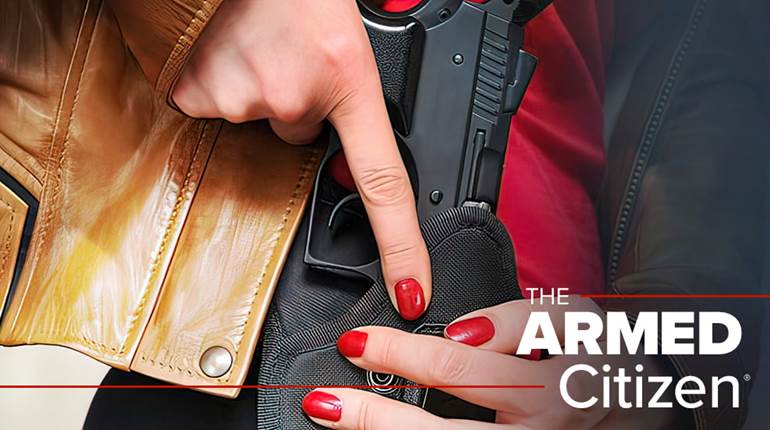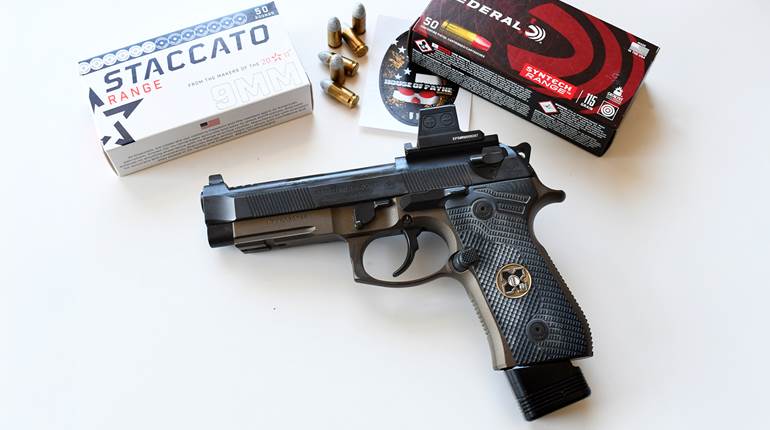
Most shooters have a “sweet spot” of which is a favorable balance of distance, shot tempo and target size for their skill level with handguns. It is common to see enthusiasts, competitors and even armed professionals struggle to speed up as they encroach closer on the target from the sweet spot and struggle to use more time to good effect as the distance stretches much beyond their preferred-and most-practiced range. The ability to modulate the degree of trigger finesse and sight refinement based on proximity to the target is one of the key skills which make good shooters … well, good.

This is the exercise space for the ‘Double & 1’ drill. Double & 1 begins a scant 2.5 yards from the target on a tight time limit of only one second to fire two shots into the NRA B8 bullseye target from the low-ready position. For each succeeding string, the distance is doubled and an additional one second is allowed; hence Double & 1. The strings look like this:
| String | Distance (Yards) | Time (Seconds) | Shots From Ready |
| 1 | 2.5 | 1 | 2 |
| 2 | 5 | 2 | 2 |
| 3 | 10 | 3 | 2 |
| 4 | 10 | 3 | 2 |
| 5 | 20 | 4 | 2 |
| Total shots 10/ Possible score 100 |
The longtime standard NRA 25-yard rapid fire bullseye pistol target is scored by the rings. The baseline version has late hits subtracting ten points to force shots within the limits and allow shooters to compare scores whether using a shot timer or the turning target systems on newer indoor ranges.
I have, at present count, no fewer than 11 variations of this drill that I use in my own practice and in training classes, but the version here is the baseline and most broadly applicable. Most shooters will find this slightly intimidating at first blush but accessible and worth their time. Double & 1 is one of those drills that forces some shooters to move much faster than their comfort zone while requiring others to slow down to bring a higher level of accountability to their hits.

I developed Double & 1 during one of the election-year ammo droughts we have all come to dread. I wanted a low-round-count drill to push accuracy to high standards under time constraint. I liked legendary SOF trainer Kyle Lamb’s "Half and Half" drill where the time limit decreases by half for rapid fire shot strings as the shooter cuts the distance in half from the previous yard line. That concept led me into development of the idea of working with shot pairs at a yard line and doubling the distance as it went back. The addition of one second has been used in Action Pistol and other exercises as a way to accommodate for increased distance, but in this case, it led to a smooth progression that accomplished what I hoped in how time translates to the shooter’s approach.
Shooters will find that, at each yard line, there is just enough time to confirm the level of sight alignment needed while working the trigger with deliberate aggression. Often where a shooter is completely unable to make the time, the culprit is an underdeveloped ability to smoothly snap the pistol up from the low ready and have it arrive on target with the sights nearly indexed. The good news is that the ability to repeatably present the handgun up from low ready and have it arrive in the shooter’s line of sight ‘ready for work’ is easily practiced at home with no ammo fired.

The broadest advice to shooting well on Double & 1 is to quickly get the pistol to the line of sight, have a firm grasp on the pistol with the support hand to counter the articulation of the trigger and be willing to take less than perfect alignment as the time and distance allow. These few tips apply at each yard line but may look and feel distinctly different as the distance and allowable time stretch.
At 2.5 yards, the pistol will often never stop moving; the shooter may trigger the first shot as the sights cross deep into the black of the bullseye and fire the follow-up shot as the front sight is still moving downward towards the rear sight notch as the slide cycles. The trigger ‘press’ at 2.5 yards consists of the shooter commanding the pistol to go without concern for finesse. Conversely, at 10 and 20 yards, the shooter must get the pistol stable and aimed while breaking the shots as cleanly as the time allows.

Some shooters have a somewhat casual understanding of where their service or carry pistol is zeroed; e.g. the sights are close enough to hit silhouette-style scoring zones confidently. Success on Double & 1 requires the shooter to have a more specific knowledge of precisely where to hold, particularly at 10 and 20 yards, to get the holes punched in the 10-ring.
Double & 1 applies well to all of the common defensive and service handguns. I developed the drill while carrying a Beretta/Langdon Tactical PX4 Compact Carry as my primary concealed-carry pistol and found it was an excellent exercise for working the double-action to single-action transition at each yard line. I also enjoy shooting Double & 1 with a wheelgun and find having to concentrate on smoothly cycling the double-action pull on a revolver while keeping the sights centered forces me to effectively use more of the available par time.

I’ve demonstrated the drill in classes with a World War I-era Webley .455 revolver to highlight that if there is time to cycle the heavy trigger on a 100-year old handgun, there is more than enough time to do accurately place shots with the typical carry or service pistol. It seems that the lighter a shooter’s trigger weight is, the more likely they are to break the shots a beat or so too soon, and time on this drill is a good way to develop more visual patience and deliberation.
As with most drill using the B8 bullseye, there are levels of achievement beyond simply score. The first step is being able to reliably keep all of the shots on the 10" square of the center target. This is roughly the scorable surface area of many professional qualification targets. The next milestone is keeping all of the hits within the 8", 8-ring; the size of the full-value zone on IDPA and Action Pistol targets. Particularly if shooting a micro-compact or a revolver, keeping the hits in the 8-ring or better (ideally with most in the black) is a solid run.
The level I like to see is when shooters can keep all of the hits in the roughly 5.5" black; the 20-yard string can make this a worthy achievement, and many shooters will be quite happy with eight shots in and the 20-yarders close by. With many of today’s optic-equipped service and competition pistols, shooters will find that 99s and 100s are absolutely within reach. Rest assured, the first time you shoot 100 will be a moment you savor.












